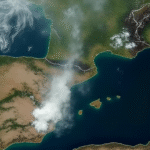Background on Key Figures and Context
Benjamin Netanyahu, the Prime Minister of Israel, has been under significant pressure to secure the release of two Israeli hostages held in Gaza. The hostages, Rom Braslavski and Evyatar David, were shown in deteriorating health in videos released by Hamas and Palestinian Islamic Jihad (PIJ) on Thursday. This situation has reignited debates in Israel about the urgent need for a captives agreement.
Who are the key figures?
- Benjamin Netanyahu: Prime Minister of Israel, facing intense pressure to secure the release of hostages.
- Julian Larison: Head of the ICRC delegation in the region, with whom Netanyahu communicated regarding humanitarian aid for hostages.
- Hamas: The de facto governing authority in Gaza, responsible for the hostages’ detention and demanding humanitarian corridors.
- Kaja Kallas: High Representative of the EU for Foreign Affairs and Security Policy, who condemned the hostage situation and called for immediate release.
- Friedrich Merz: German Chancellor, expressing horror but urging Israel to continue humanitarian aid supply in Gaza.
Events and Demands
Netanyahu contacted the ICRC, requesting food and medical attention for the hostages. In response, Hamas stated it would positively consider any ICRC requests but demanded the opening of humanitarian corridors for food and medicine supplies into Gaza.
Hamas’ Conditions
Hamas emphasized that they do not deliberately starve prisoners but noted that the hostages would receive no special treatment while the blockade and starvation policies persist.
ICRC’s Stance
The ICRC regional delegation expressed concern over the recent videos and stressed that the dire humanitarian situation must end. The ICRC has not provided further comments at this time.
International Reactions
The UN reported a widespread hunger threat in Gaza, while the EU and Germany condemned the hostage situation and called for immediate release. Israel’s Defense Forces reported killing at least 60,430 people in Gaza, mostly civilians, according to the Palestinian Health Ministry.
Conflict Background
The conflict began with a Hamas attack in Israel on October 7, 2023, resulting in 1,219 deaths (mostly civilians) and the abduction of 251 people, including 49 still held in Gaza. In retaliation, Israel reportedly killed at least 60,430 people in Gaza, mostly civilians.
Current Situation in Gaza
Israel has maintained a blockade on Gaza, home to over two million Palestinians living in congested conditions. Although Israel lifted the total humanitarian blockade in late May, it only permits limited aid entry deemed insufficient by the UN.
On Sunday, at least 26 people died due to Israeli gunfire or bombardment, including nine near a humanitarian aid distribution center in Gaza.
An employee of the Palestinian Red Crescent and three others were injured in an Israeli attack on the organization’s Jan Yunis office in southern Gaza. The ICRC and UN have called for respect and protection of humanitarian personnel.
Key Questions and Answers
- Who are the hostages? Rom Braslavski and Evyatar David, two Israeli citizens held captive in Gaza.
- What demands is Hamas making? Hamas is demanding the opening of humanitarian corridors for food and medicine supplies into Gaza.
- What is the international community’s stance? The EU, Germany, and the UN have condemned the hostage situation and called for immediate release.
- What is the current humanitarian situation in Gaza? Gaza faces a widespread hunger threat, with limited aid entry and ongoing blockade by Israel.





